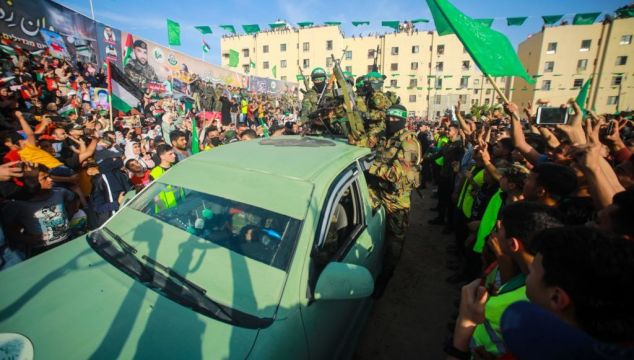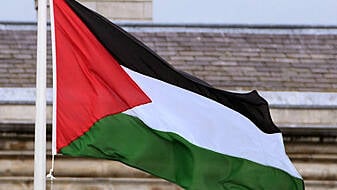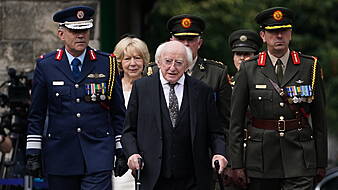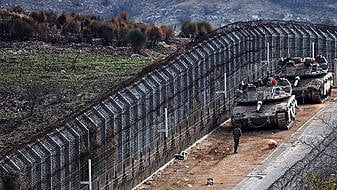Mohammed Deif, Hamas’ longtime shadowy military leader and one of the alleged masterminds of the October 7th attack on Israel that sparked the war in Gaza, is said to be dead following an Israeli airstrike last month.
The Israeli military said it killed Mr Deif in a massive strike in southern Gaza on July 13th, citing “an intelligence assessment”.
One of the founders of Hamas’s military wing, the Qassam Brigades, in the 1990s, Mr Deif led the unit for decades. Under his command, it carried out dozens of suicide bombings against Israelis on buses and at cafes and built up a formidable arsenal of rockets that could strike deep into Israel and often did.
He gained mythical status among Palestinians, surviving a string of Israeli assassination attempts and not showing his face in public for decades. For years, he topped Israel’s most-wanted list.
Israel says Mr Deif and Hamas’s political leader in Gaza, Yahya Sinwar, were the chief architects of the October 7th attack. Together they succeeded in foiling Israel’s vaunted border defences, surprising the region’s most powerful military and unleashing an unprecedented attack that killed 1,200 people, mostly civilians, and took roughly 250 others hostage into Gaza.
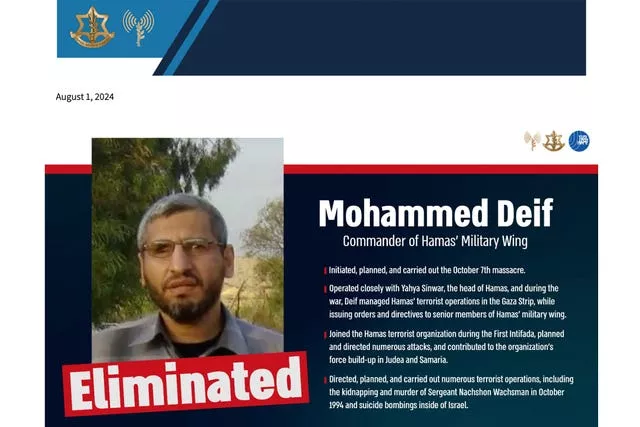
The attack triggered the Israel-Hamas war that has killed more than 39,000 Palestinians, according to the Gaza Health Ministry.
On the morning of the attack, Hamas issued a rare voice recording of Mr Deif announcing the “Al Aqsa Flood” operation. In the message, he railed against military raids in the occupied West Bank and violence in east Jerusalem and called on all Palestinians to rise up and take part.
“Enough is enough,” he said. “Kill, burn, destroy and block the roads. Make them understand that the Al Aqsa Flood is more powerful than they think and believe.”
The military’s claim that he was dead came a day after Hamas’s political leader Ismail Haniyeh was killed in an alleged Israeli strike on Tehran.
Those developments could help set the tone for the remainder of the war. They could imperil ceasefire talks and raise fears of a regional escalation.
But the alleged demise of Mr Deif, a long-wanted figure said to be behind the deadliest attack in Israel’s history, would also be a major win for Israel. It could present prime minister Benjamin Netanyahu with a political off-ramp to end the war, allowing him to retreat from his lofty promises of “total victory” while showing Israelis that Hamas’ military capabilities suffered a debilitating blow.
At the same time, his killing would be a significant setback for Hamas, both symbolically and strategically, since it may have lost a unique player in the Palestinian armed struggle against Israel, even if that struggle likely will not end with Mr Deif’s alleged death.
Born Mohammed al-Masri and believed to be 58 or 59, his nom de guerre, Deif, means “guest” in Arabic — a moniker that reflected his tendency to change locations frequently to hide from Israel.
Mr Deif, like Mr Sinwar, grew up in a refugee camp of the southern Gaza city of Khan Younis in the mid-1960s. Gaza is home to several such camps whose inhabitants fled or were forced from their homes in what is now Israel during the war surrounding the country’s establishment in 1948.

He is believed to have joined Hamas shortly after the formation of the Islamist Palestinian group in the late 1980s, at the onset of the first Palestinian intifada, or uprising. The group’s ideology calls for armed resistance and the violent destruction of Israel.
In 1989, during the height of the uprising, Mr Deif was arrested by Israel but later released.
Michael Koubi, a former director of the investigations department at Israel’s Shin Bet domestic security agency, is one of the few Israelis to have met Mr Deif personally when he was a quiet, bookish 16-year-old imprisoned in a detention facility in Khan Younis for throwing stones and Molotov cocktails at Israeli soldiers.
“He was very, very patriotic, very involved in the intifada,” Mr Koubi said.
He would go on to found Hamas’s network in the West Bank in 1993, the year that Israel reached an interim peace agreement with the Palestine Liberation Organisation, the Israeli military said. That same year, he was also promoted to the head of Hamas’s armed wing, it said.
Israel holds Mr Deif responsible for plotting many attacks that killed scores of Israeli civilians, including the kidnapping and killing of Israeli soldier Nahshon Wachsman in the West Bank in October 1994, and suicide bombings in Jerusalem and Ashkelon in 1996.
The attacks in the mid-90s are widely believed to have tipped the 1996 Israeli election in favour of Benjamin Netanyahu, who eked out a surprise victory over the more moderate front-runner Shimon Peres.
Under Mr Netanyahu’s lengthy leadership and his successive nationalist governments, the prospects of an independent Palestinian state have grown dimmer, chances that have further diminished because of Hamas’s attack and the war.
Under Mr Deif’s watch, Hamas developed its rocket programme, beginning with rudimentary weapons capable of travelling just a few kilometres and evolving into an arsenal that struck deep inside Israel, reaching its seaside metropolis Tel Aviv and the foothills of Jerusalem.
He was also in command when soldier Gilad Schalit was kidnapped into Gaza in 2006. Mr Schalit would be released five years later in exchange for more than 1,000 Palestinian prisoners held in Israeli jails, a trade that set Mr Sinwar free.
Mr Deif is also thought to have helped expand Hamas’s labyrinth of underground tunnels in Gaza — where he is believed to have hidden during the ongoing war.
Mr Koubi said Mr Deif’s fingerprints were all over the October 7th attack, from its sweeping scope to the more surprising aspects such as the paragliders who flew over the fence and landed in the border communities at the start of the attack.
“He was very creative,” he said.
There are few photos of Mr Deif, and he is thought to be unrecognisable to most Palestinians.
He has been so elusive that even his appearance was a point of speculation. Some media reports say he was paralysed and used a wheelchair for years following injuries he sustained during past assassination attempts, while others reported he was able to walk unassisted.
In 2014, Palestinian media said his wife and two children were killed in an Israeli airstrike, one of the many failed attempts to kill him.
Moshe Fuzaylov, a long-time investigator and former senior official for the Shin Bet, said that if Mr Deif was killed, it could open a window of opportunity where Hamas will be in disarray, including over Mr Haniyeh’s death. It could push the group toward a ceasefire with Israel while they are in a weakened state.
“It’s a morale hit and a very strong operational hit, and it changes this organisation from something that has two legs to lean on to one that is limping,” he said.
But it would not necessarily be a death blow for Hamas.
“Israel has targeted Hamas political and military leaders in the past,” said Khaled el-Gindy, an analyst specialising in Palestinian affairs with the Washington-based Middle East Institute.
“But leaders are always replaceable.”
